On every car a basic differential is fitted to distribute the engine's power to the driving wheels. The basic differential gear supplies the power to the wheels which is/are loaded with least resistance.
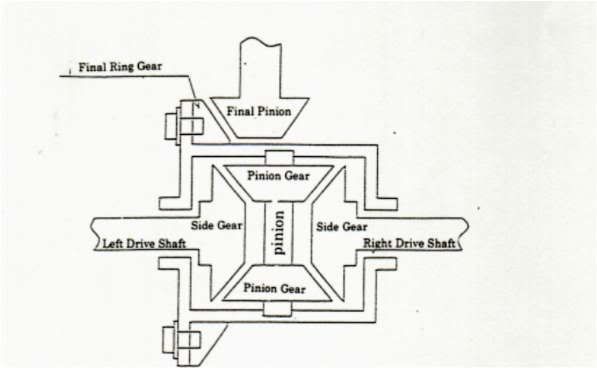 This allows the car's wheels to run at different speeds in a turn with least resistance. However, when a car is cornering close
This allows the car's wheels to run at different speeds in a turn with least resistance. However, when a car is cornering close  to it's limit, the car will exhibit roll, a leaning to one side, causing the inside tire(s) to lose forward traction and lateral grip. The wheels lift and cause excessive spin because of lack of downward force or weight distribution. This wheel spin is useless for acceleration until the tire(s) regain traction and start to translate the power to the ground. Limited Slip Differential (LSD) is needed to alleviate this wheel spin.
to it's limit, the car will exhibit roll, a leaning to one side, causing the inside tire(s) to lose forward traction and lateral grip. The wheels lift and cause excessive spin because of lack of downward force or weight distribution. This wheel spin is useless for acceleration until the tire(s) regain traction and start to translate the power to the ground. Limited Slip Differential (LSD) is needed to alleviate this wheel spin.Limited Slip Differential
An LSD is constructed similarly to the normal differential As you can see, the pressure plate rings have the side gear, the pinion and the pinion gears locked inside and behind each pressure rings are a number of clutch plates.
 When torque is applied to the differential, the differential case will rotate and throw the pinion into the pressure ring cam. The pressure ring is then pushed out against the clutch plates thereby squeezing them together. This in turn causes the wheels to gradually lock together, depending on the power applied. This effect limits the wheel spin during hard cornering and applies power to the wheels evenly when more power is applied. On acceleration and deceleration, it provides even grip and on neutral power, it frees up for less drag and easier turning.
When torque is applied to the differential, the differential case will rotate and throw the pinion into the pressure ring cam. The pressure ring is then pushed out against the clutch plates thereby squeezing them together. This in turn causes the wheels to gradually lock together, depending on the power applied. This effect limits the wheel spin during hard cornering and applies power to the wheels evenly when more power is applied. On acceleration and deceleration, it provides even grip and on neutral power, it frees up for less drag and easier turning.Different Type of LSD Configurations (1 Way, 1.5 Way & 2 Way)
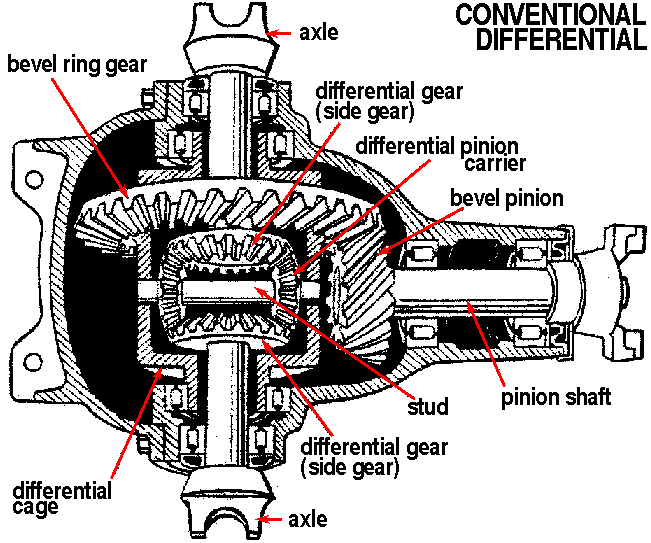 A 1 way differential means that the cam is shaped in such way as to have positive lock only when accelerating.
A 1 way differential means that the cam is shaped in such way as to have positive lock only when accelerating.The 1.5 way functions almost same as a 2 way but provides less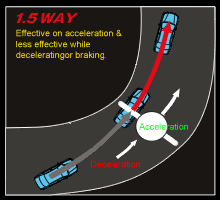 lock when decelerating. The 1.5 way can provide more forgiving balance when braking than a full 2 way setup, although it is less effective for true racing applications, it provides easier operation for beginners in throttle off conditions. 1.5 way is also very effective for front wheel drive cars which need extra stability during braking.
lock when decelerating. The 1.5 way can provide more forgiving balance when braking than a full 2 way setup, although it is less effective for true racing applications, it provides easier operation for beginners in throttle off conditions. 1.5 way is also very effective for front wheel drive cars which need extra stability during braking.
 lock when decelerating. The 1.5 way can provide more forgiving balance when braking than a full 2 way setup, although it is less effective for true racing applications, it provides easier operation for beginners in throttle off conditions. 1.5 way is also very effective for front wheel drive cars which need extra stability during braking.
lock when decelerating. The 1.5 way can provide more forgiving balance when braking than a full 2 way setup, although it is less effective for true racing applications, it provides easier operation for beginners in throttle off conditions. 1.5 way is also very effective for front wheel drive cars which need extra stability during braking.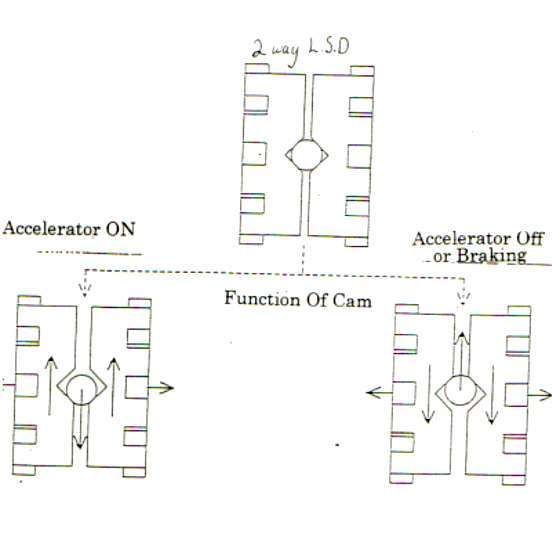
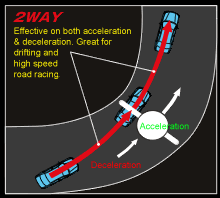 The 2 way is constructed in a way to have positive lock motion in both acceleration and deceleration mode
The 2 way is constructed in a way to have positive lock motion in both acceleration and deceleration modeComparison of LSD
The OEM supplied LSD, standard and optional on many cars today are 2 pinions. This design has very low positive lock and it is designed to provide some sporty feel to the showroom cars. Because of the nature of this low lock design, it is just slightly more effective than not having one at all. Not a choice for true performance drivers.
A performance LSD should have at least 4 pinions. This is the design used for racing and rallies around the world. The positive lock ratio and linear lock characteristics are determined by a number of components. The cam profile, clutch plate quantity and size, initial torque of the preload springs and the lubricants.A viscous type, torsen type and helical type are some of other designs used as OEM equipment or optional LSD unit. These designs are commonly used since they are less aggressive and easier to maintain than the clutch type racing LSD unit. In order to achieve the maximum traction control, most OEM performance divisions and aftermarket manufactures use the clutch type design for their LSD unit.












No comments:
Post a Comment